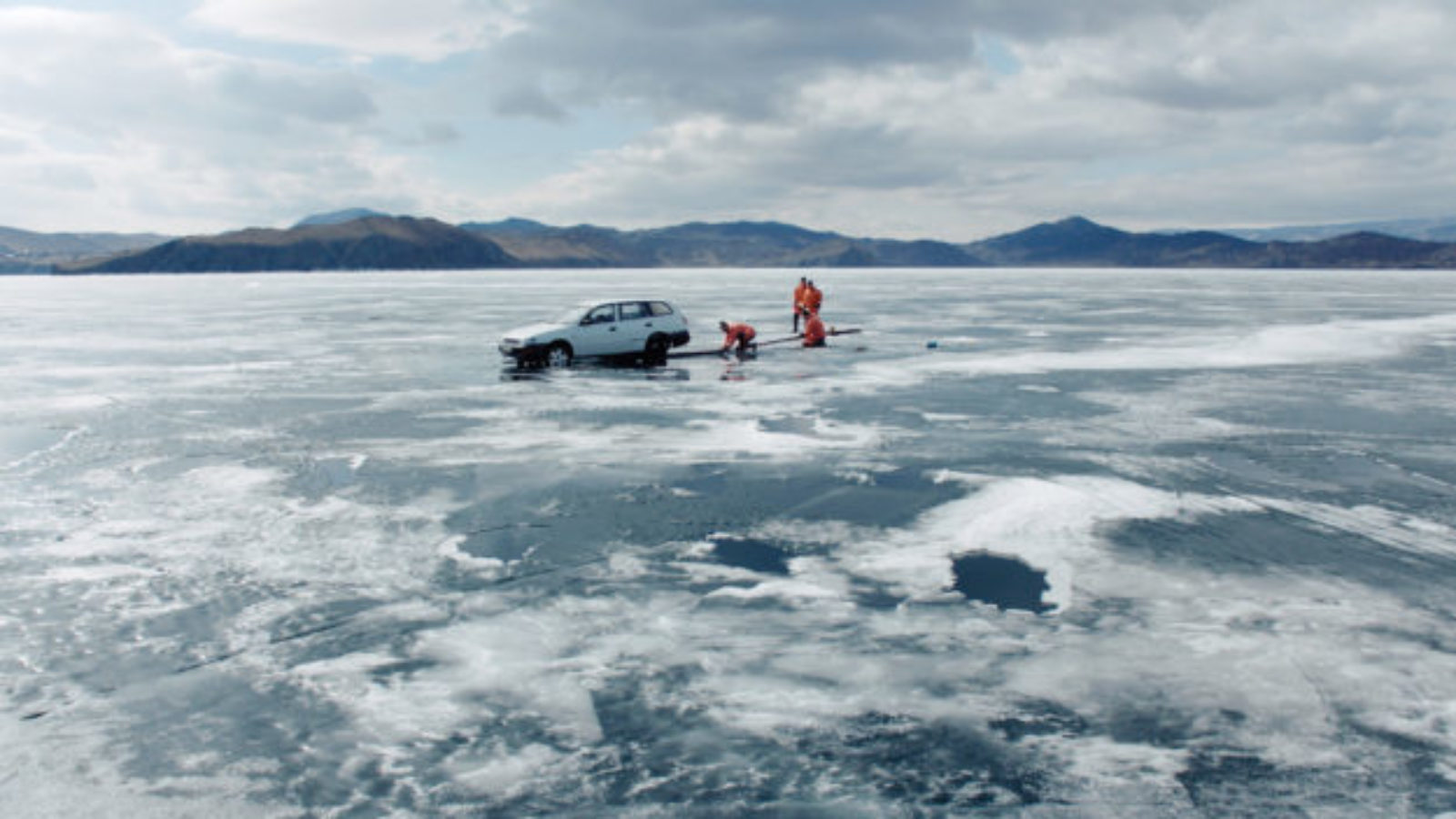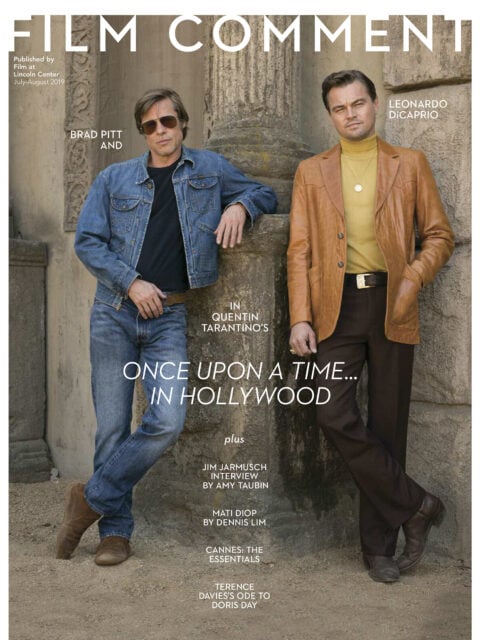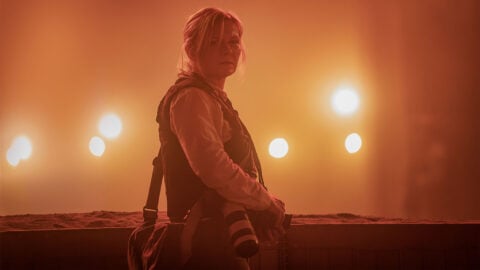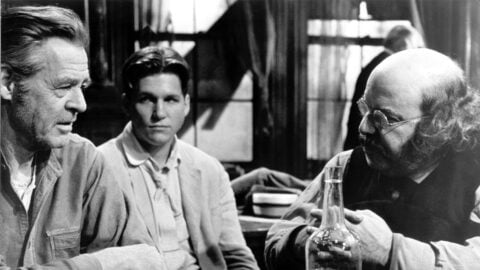By Fatima Naqvi in the July-August 2019 Issue

The Big Screen: Aquarela
(Victor Kossakovsky, UK/Germany/ Denmark/USA, Sony Pictures Classics, Opening August 16)
In Victor Kossakovsky’s masterful essay film Aquarela, water in all its forms provides the scale against which human life is to be measured. We watch it metamorphose from ice to liquid, snow to rain to mist. In the beginning, there are rocky coasts, barren islands, and sheltering inlets from which to espy the surrounding waters. It is from an outcropping that we first see the vast expanse of Lake Baikal, the world’s most ancient freshwater lake, in a languorous pan. We move down to its frozen surface, where men are searching for something below—cars that have broken through the ice. As the film continues, we travel westward toward Greenland, Florida, and Venezuela. There are less and less people, more calving glaciers, viscous waves, pounding storms, and shuddering waterfalls. The shape-shifting, devious element is shown from overhead and underneath; it is also presented from an intimate eye level. Water takes over the screen, and we take on the perspective of a drowned man.

From the July-August 2019 Issue
Also in this issue
Water has always conjured up exposure and rescue; since antiquity, it has provided the foil for conceptions of political life. For the great German thinker Hans Blumenberg, the loss of life at sea is a recurring theme in philosophical thought: no Horace or Leibniz, no Zenon or Aristippus without a shipwreck. A philosopher who has not experienced near-death on water cannot be trusted, writes Blumenberg. Who can teach of last things and next-to-last things if he has not been exposed to them, not undertaken the fateful step from safety to the boundless, immoderate waters?
Director Kossakovsky’s team, filming chiefly on watercraft, retraces the philosophical journey par excellence—and its near wreckage. In Aquarela’s central segment on a sailboat, the film sets us adrift to inspire awe, evoke terror, and—at 48 frames per second—induce vertigo. On a peaceful day, a boat glides into view in long shot, its white sails mimicking the silhouettes of the surrounding icebergs. The winds shift, and two sailors try to steer the craft through the resulting squall. The audio records the woman’s grunts as she throws herself into her work, water crashing over her. The lack of dialogue and camera’s position make clear how serious the situation is. Aquarela’s crew, invisible but ensconced with the seafarers, brings us into this harrowing situation to make us ponder our total exposure. We don’t need to be told that the forces unleashed by global warming will find us when the ice has melted—and the film thankfully avoids all commentary, even refraining from explanatory intertitles. Although the film ends with a rainbow beneath the stunning waters of Angel Falls, we feel we have only narrowly escaped. And we shouldn’t deem ourselves too secure: after this film, terra firma no longer feels like a given. Reversing directionality (why is the rainbow below the water?) and pulling back to situate us vis-à-vis the world’s highest waterfall provide no solace or grounding.
Kossakovsky’s film is dedicated to fellow Russian filmmaker Alexander Sokurov. In attempting to experiment with new forms of representation, Kossakovsky, too, sets his camera free. If Russian Ark brought Sokurov to global attention with one gliding, unbroken long take, Aquarela flies as well, across the globe. The camera’s mobility allows Kossakovsky to abstract from the water, creating suggestive patterns from both afar and close up. Water has held a privileged place in his oeuvre from the outset: his first film, Belovy (1992), is set at the mouth of a river in a small village between Moscow and St. Petersburg; the camera is placed on a little boat and travels 1,000 kilometers to the North Sea. Bornholm, a Danish island off the southern coast of Sweden, provides the setting for Kossakovsky’s 2000 film I Loved You. In this case, a window onto the Baltic plays an important role. In Aquarela, the director tries to push the cinematic element further. Crisp zigzags on ice create a lattice; water looks like black, viscous oil; an interwoven pattern of brown and yellow evokes unfurling tapestry. Aquarela artfully evokes the legacy of the avant-garde— such as Joris Ivens’s Rain from 1929—to make a contemporary experimental work, one that embraces total immersion.
The Dolby Atmos soundtrack adds to the film’s encompassing experience. It carefully transitions between the Finnish “cello metal” band Apocalyptica, the sounds of water, and human signals for disaster. Any comprehensive discussion of this film will have to account for the syncopated rhythms, the sound bridges, and the sirens; near the beginning, the bursting of the ice on Lake Baikal punctuates the film images like small explosions, offering an ambiguous commentary. The conflagrations to come, when sea levels rise, may move this sound out of nature’s register and back into man’s. In moments like the bursting of the ice, the film, in all its grandeur and careful unfolding, becomes apocalyptic in its own right. In asking us to contemplate water’s power and its densely metaphoric nature, we realize our extreme dependence on it in more senses than one.
Fatima Naqvi teaches German and film studies at Yale University.







